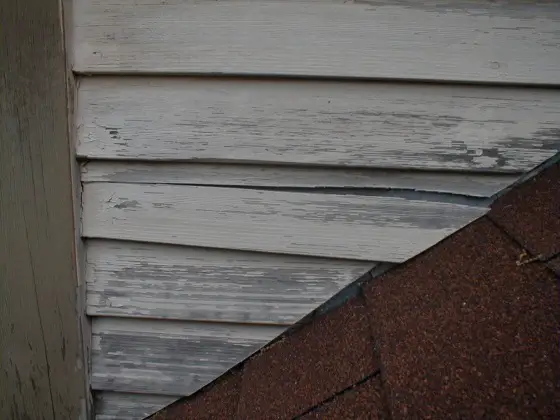Cracks in Wood Siding

The splits in the siding material concern me. My guess is that the siding was not installed correctly when the houses were built.
DEAR TIM: I live in a landominium development where we all have separate houses. Each house is covered with beveled cedar wood lap siding that splits for no reason. Our maintenance committee insists that all split boards be replaced before the outside of a unit is painted. This seems extreme to me. I thought cedar would be a long lasting material. Do the boards really need to be replaced or can the splits boards be caulked? Jim G., Riverside, CA
DEAR JIM: The maintenance committee is doing the right thing. The boards with splits should be replaced. These splits allow rainwater to penetrate deeply into the wood and in some instances behind the wood. Water is an enemy to painted finishes and wood that has not been treated to prevent rot. A new paint job can blister and peel within six months if enough water gets behind the wood siding. You are correct about the longevity of cedar siding. It is a wonderful renewable forest product that contains natural preservatives. But water that saturates the wood sheathing or framing lumber behind the siding may start to rot in a short amount of time.
The splits in the siding material concern me. My guess is that the siding was not installed correctly when the houses were built. Inexperienced carpenters often nail lap siding so that each piece of siding is unable to move. Lap siding is installed so that each piece overlaps the one below it. This overlap creates an excellent weather barrier so that rain water is shed from the siding. Rookie carpenters often nail along the bottom edge of the siding and this same nail pierces the top portion of the piece of siding just below.
This method of nailing pins each piece of siding and makes it nearly impossible for the siding to expand and contract with changes in the weather. Experienced carpenters know that the nails from one piece of siding must not pass through the siding below. If the overlap of the two pieces of siding is one and one quarter inches, then the nail for a piece of siding should be one and three eighths above the bottom edge. This nail spacing allows each piece of siding to float and move easily. Be sure that the painters nail the siding properly as they replace each split board.
When the split board is being replaced look to see if a water barrier membrane is in place. Years ago tar paper was used by carpenters beneath beveled lap siding. It is still a very effective material to use if you do not want water to contact the framing lumber and wall sheathing. Modern fabric water and air infiltration barriers can also be used. These products come in large rolls and are easy to recognize. If you do not see any water barrier behind the siding, then it is vitally important that new siding be installed. In this case, the siding is the only weather barrier. Felt paper and the modern fabric barriers offer an important second line of defense.
If you want to maximize the life of the houses and the paint jobs be sure that the siding is nailed with hot dipped galvanized nails or better yet, stainless steel nails. These nails have the highest corrosion resistance and are worth the extra cost. Be sure the nails are long enough so that the nail shaft penetrates at least one and one half inch into solid wood once it passes through the siding.
The paint job on the replacement piece of siding will last a very long time if the painter can paint both the back and cut edges of the wood before it is installed. When wood siding is completely covered with paint, water has a difficult time getting into the fibers. If you keep wood completely dry using this method, it becomes dimensionally stable. High quality paint will adhere to this wood for many years.
Column 363